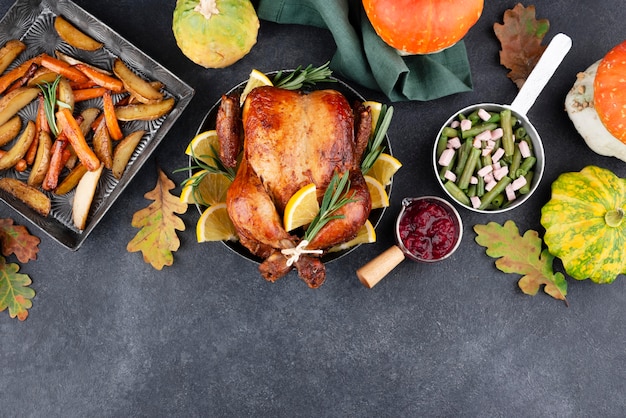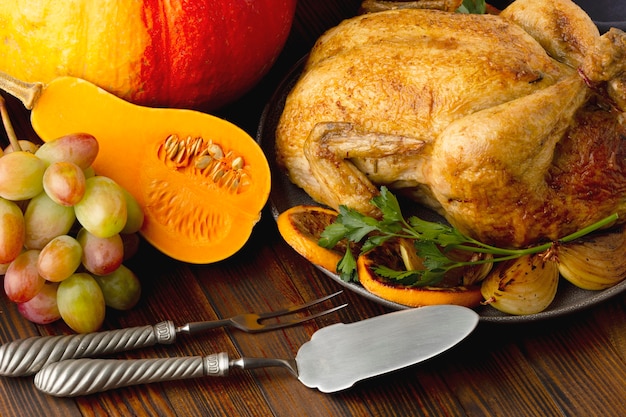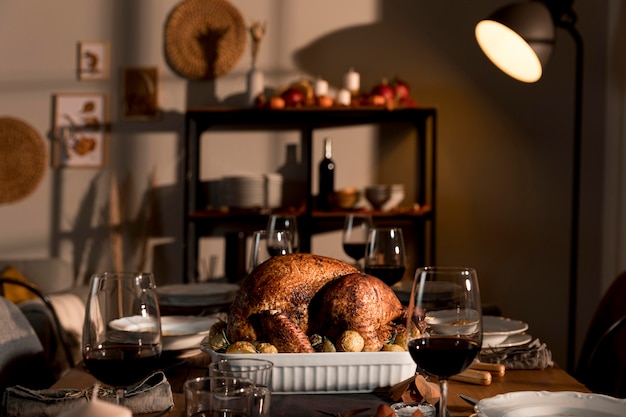Let's face it, the festive season brings a lot of joy, but also a fair bit of stress. And for many of us, that stress peaks when it comes to cooking the star of the show: the turkey. But fear not, my fellow food enthusiasts, because I'm here to demystify the art of turkey cooking, sharing my hard-won wisdom and insider tips to help you create a truly memorable feast.
I'll be honest, my first attempt at roasting a turkey was a bit of a culinary disaster. It was dry, tough, and frankly, a bit of a let-down. But over the years, I've learned a thing or two about turkey roasting, and I'm here to guide you through every step, from choosing the perfect bird to carving it like a pro.
(Part 1) The Great Turkey Selection
The journey to a perfect roast turkey starts with choosing the right bird. Like choosing a good bottle of wine, it's all about finding the right fit for your needs.
Size Matters, My Friend
The size of your turkey is paramount. It's all about finding the right balance for your guest list. A general rule of thumb is to allow about 1.5 pounds of turkey per person. So, if you're hosting a gathering of 10, a 15-pound turkey should do the trick.
Free-Range or Not?
Now, here's a matter of personal preference. I'm a big fan of free-range turkeys. The birds have more room to roam, and I find the flavour is richer and more intense. But, at the end of the day, it's your choice.
Stuffing: A Delightful Dilemma
If you're planning on stuffing your turkey, remember to factor that into your size calculations. Stuffing takes up space, so you'll need a slightly larger bird to accommodate it. I always recommend making your stuffing separately, as it often doesn't cook thoroughly inside the turkey.
(Part 2) Prepping Your Turkey for the Roast
Now that you've got your turkey, it's time to get it ready for its starring role. This is where a little TLC goes a long way.
A Thorough Rinse
First, give your turkey a good rinse, inside and out, under cold water. This will remove any excess residue and prepare it for the next step.
Pat It Dry
After rinsing, pat the turkey dry with kitchen paper. This ensures that the skin will crisp up nicely during roasting.
Salt It Right
Here's a little trick that'll elevate your turkey: salt it the day before roasting. It's a simple technique that helps lock in moisture and enhances flavour. Simply sprinkle a generous amount of salt all over the turkey, tuck it into a roasting tin, and pop it in the fridge overnight.
(Part 3) Roasting Your Turkey: The Art of Heat

The oven is your canvas, and the turkey is your masterpiece. It's all about finding the right temperature to bring out the best in your bird.
The Goldilocks Temperature
A good rule of thumb is to cook your turkey at 325°F (160°C). This ensures even cooking and browning. But, always check the instructions on the turkey packaging, as they might differ slightly.
Space is Key
Make sure you have enough space in your oven to accommodate the turkey. You don't want it to be cramped, which can hinder even cooking.
(Part 4) turkey cooking time: Cracking the Code

Now we come to the heart of the matter: how long do you cook that magnificent bird? It's all about finding the sweet spot between tenderness and doneness.
The Time Calculation
The most common method for calculating cooking time is to allow 15-20 minutes per pound of turkey. For instance, if you're working with a 15-pound turkey, you'll need to cook it for 3.5-4 hours.
My Secret Trick
Here's a little trick I've picked up over the years: I like to cook my turkey for a few minutes less than the recommended time. This helps ensure the meat is juicy and tender, with a hint of pinkness at the center.
(Part 5) Checking for Doneness: A Crucial Step

No one wants a raw turkey, so make sure you check for doneness before serving.
The Thermometer Test
The most reliable method is using a meat thermometer. Insert it into the thickest part of the thigh (avoiding any bone), and make sure it reaches 165°F (74°C).
The Leg Trick: A Less Reliable Option
If you don't have a meat thermometer, you can try the leg test. Gently move the leg. If it moves freely, the turkey is likely cooked. However, this method is less reliable than using a thermometer.
(Part 6) The Art of Turkey Rest: A Crucial Phase
You've got your beautifully roasted turkey out of the oven, but don't rush to carve it!
Let It Rest, My Friend
It's vital to let the turkey rest for at least 30 minutes before carving. This allows the juices to redistribute throughout the meat, ensuring it remains juicy and succulent.
Keep It Warm and Cosy
While you're waiting, cover the turkey with foil to keep it warm and prevent it from drying out.
(Part 7) Carving Your Turkey: A Masterful Finish
Now comes the moment of truth. It's time to carve that gorgeous bird, creating a masterpiece of edible art.
The Right Tools
You'll need a sharp carving knife for this job. If you don't have one, you can use a good quality chef's knife.
Following the Grain
When carving, follow the grain of the meat to make nice, neat slices. Start with the legs and thighs, then move on to the breast.
(Part 8) Serving Your Turkey: A Feast for the Senses
Finally, it's time to enjoy the fruits of your labor!
Presentation is Key
Serve your turkey with all your favourite sides, such as roast potatoes, gravy, stuffing, and cranberry sauce. A well-presented dish will elevate your turkey to new heights.
Sharing the Joy
And, most importantly, share your delicious turkey with your loved ones. It's a festive tradition that brings people together.
(Part 9) turkey leftovers: Culinary Magic
Don't worry if you have some leftover turkey. You can use it for all sorts of delicious dishes.
turkey sandwiches: A Classic
A classic for a reason! Simply slice up some leftover turkey and add it to sandwiches with your favourite fillings.
turkey soup: A Hearty Comfort
Turn those leftovers into a hearty and comforting turkey soup.
Turkey Curry: A Flavourful Twist
For a change of pace, try a turkey curry. The leftover turkey takes on new life with fragrant spices.
(Part 10) FAQs: Unveiling the Mysteries
Here are some common questions you might have about cooking a turkey:
1. Can I Cook a stuffed turkey?
Yes, you can cook a stuffed turkey, but it's important to make sure the stuffing is cooked thoroughly. The stuffing should reach an internal temperature of 165°F (74°C). I personally recommend making the stuffing separately, as it often doesn't cook thoroughly inside the turkey.
2. How Long Can I Leave a Turkey Out Before Cooking?
It's best to keep your turkey refrigerated until you're ready to cook it. However, if you're planning on cooking it within 2 hours of thawing, you can safely leave it out at room temperature.
3. What Temperature Should I Cook My Turkey at?
Generally, the recommended oven temperature for cooking a turkey is 325°F (160°C). However, it's always best to check the instructions on the turkey packaging.
4. How Do I Know If My Turkey is Done?
The best way to check for doneness is to use a meat thermometer. Insert it into the thickest part of the thigh (avoiding any bone), and make sure it reaches 165°F (74°C).
5. What Do I Do With the Turkey After Cooking?
After cooking, it's important to let the turkey rest for at least 30 minutes before carving. This allows the juices to redistribute throughout the meat, ensuring it remains juicy and succulent.
(Part 11) The Ultimate Turkey Guide: Your Companion
So, there you have it, my friends! A comprehensive guide to cooking a perfect turkey. From choosing the right bird to carving it with expertise, I've shared all the knowledge I've gained over the years.
Remember, the key is to have confidence in your skills, to be meticulous with your prep, and to enjoy the process. And most importantly, embrace the joy of sharing a delicious turkey with your loved ones.
Now, go forth and conquer those turkeys! You've got this!
Everyone is watching

How to Cook Frozen Lobster Tails Perfectly: A Step-by-Step Guide
RecipesLobster. Just the word conjures up images of lavish meals, special occasions, and a taste of luxury. But let's...

Pigs in a Blanket Cooking Time: How Long to Bake for Perfect Results
RecipesAh, pigs in a blanket. Just the name conjures up images of those delightful little parcels of crispy pastry en...

Pork Fillet Cooking Time: How Long to Cook It Perfectly
RecipesPork fillet, or tenderloin as it's sometimes called, is a real favourite in our house. It's so versatile, and...

The Ultimate Guide to Cooking Delicious Frankfurters
RecipesLet's face it, we all love a good frankfurter. It's a classic, simple, and always satisfying. But let's be rea...

The Ultimate Guide to Tender, Juicy Pulled Pork
RecipesRight, let's talk pulled pork. It's one of those dishes that just screams "comfort food," doesn't it? I mean...
